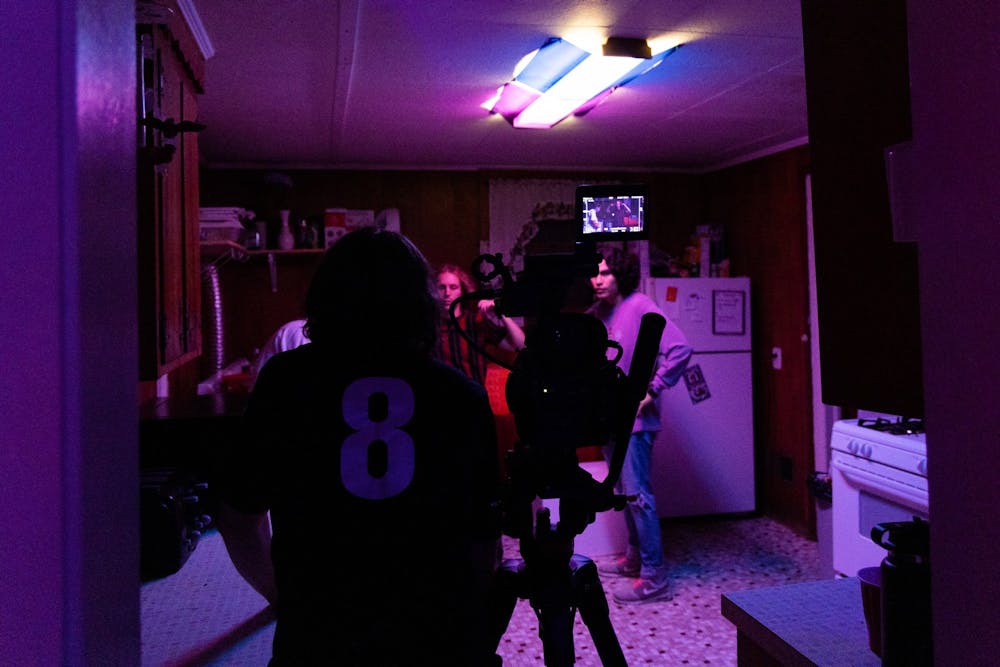Since coming out with their first short film on YouTube in March 2020, Soapwater Productions is taking another big step in their career with the making of their first full-length feature film, “To What End.”
The group, comprised of USC graduates Max Joseph, John Slice and Fen Rockwell, said that while this milestone was always a subconscious goal, they went into filming with the mentality to overcome a new challenge.
“The biggest thing, as a group, going into it was, ‘Do we have what it takes to make this thing happen?’” Rockwell, the producer of Soapwater, said. “That’s a huge lesson that you would want to learn from doing something of this scale.”
Co-written by Max Joseph, the director and composer for Soapwater, and his brother Jacob Joseph, the film follows Sebastian Ortega, a young man who tries to take care of his sick grandmother but spreads himself too thin with other obligations.
“He’s trying to prioritize (his grandmother). He’s trying, he’s not doing his best, and these other factors, variables — whatever you want to call them — are kind of keeping him from getting to helping his grandmother.” Max Joseph said. “He just wants to help too many people, and it’s more of a flaw than a redeeming quality for him.”
Max Joseph said he drew inspiration for the film from his own life where he kept getting pulled in different directions. For him and Rockwell, the film is a “cautionary tale” that leaves the audience with the desire to change their own lives.
“It’s like a visual tale, visual story, that you’re being told through these characters, through visual components. And then at the end, you’re given this resounding feeling of like, ‘I need to prioritize the things that matter most to me in life,’” Rockwell said.
Leading up to the start of production, Slice, the director of photography and editor of the film, said his biggest concern was the functionality of each scene. He said that for their first night of filming, they had to attach their only camera to the top of a car with just a suction cup and safety cables holding it down.
“We only have one camera so if something happened to it in the first night … we don’t have a movie,” Slice said.
The group filmed “To What End” over a two-week period from June 10-24. During those two weeks, they sometimes worked 18-hour days, staying up until 2 or 3 a.m. to finish shooting a scene.
According to Rockwell and Max Joseph, there were some days during filming that were “inefficient” where scenes that had been previously planned out didn’t work.
“Filmmaking just takes time, and if we want to make this worth it and make this as good as we know it can be, then we just have to accept the fact that we’re gonna have some longer nights,” Rockwell said.
In these moments, Max Joseph said he would lean on the cast and crew for a different perspective on how a scene should be directed.
“It’s important to reflect on yourself, but it's also important to hear from people who see what you don’t necessarily see of yourself,” Joseph said.
In the past, Soapwater has only made short films, with their longest film “A Fair Life” running almost 27 minutes. According to Rockwell, “To What End” — like any feature film — was more demanding due to the need for a larger budget and more locations than their previous projects.
The group shot eight to 10 different locations, using their own house to film a party scene and a house across the street for Ortega’s living space. Due to a limited budget, Rockwell and set supervisor Sabri Irizarry compiled personal items from their homes and attics, putting up records and posters to bring Ortega’s space to life.
“A lot of set design, especially when dealing with a low budget, it’s really just kind of working with what you have because you’re really in a box when you have no money,” Irizarry said.
Despite these limitations and other complications while filming, the group said they continued to push through obstacles by thinking about the people who supported their film through time and money.
“I would just start thinking about how much my friends and family are putting on the line as well,” Slice said. “We have other people kind of expecting a lot from us.”
While they may have experienced some roadblocks while filming, Rockwell said he is still proud of how far in the production process Soapwater has come.
“I think it’s good to take a step back and recognize and put things into perspective and be like, ‘We’re in a good place,’” Rockwell said. “We haven’t even made this film complete yet, so it’s a lot more work to do, but it just did feel really, really good to check that off and push through that challenge.”
With the release of their film, Max Joseph and Rockwell said they hope that it will push other people in the Columbia film community to create more local films, bringing more competition to the area and driving film makers to want to make better films than their peers.
“We see other people’s films … you respect other people’s projects, you respect their work ethic, but you want, you have like an innate desire to one-up them,” Rockwell said.
For right now, Soapwater will be editing the film and writing music in the coming months as they prepare for the premiere of “To What End” at the Nickelodeon Theatre in November 2022.

